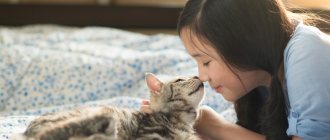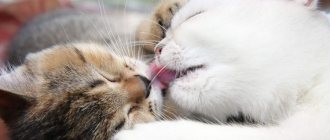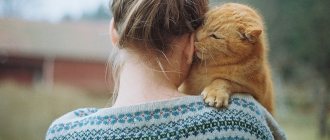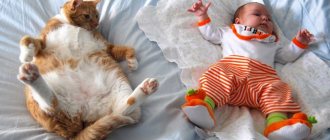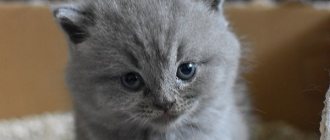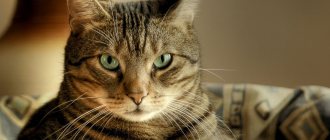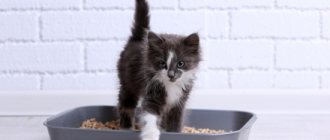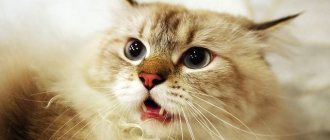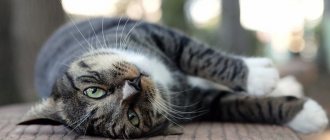Cats do not express their emotions as clearly as dogs. Sometimes cat behavior is difficult to interpret, but this does not mean that your pet will forever remain a mysterious creature for you.
The sounds he makes, body movements and everyday behavior will tell you how your furry family member feels. If you pay attention to them, you can not only learn to understand your pet’s personality traits and habits, but also see the slightest changes in his mood and health.
Meowing
An adult cat meows less often than a kitten, but in a very special way. If the tone is low, it means she is dissatisfied or unhappy for some reason. A high tone means she is in good spirits, and if the meowing is repeated, it means she wants your attention. You will soon learn to understand what your pet is “saying”: “let me go,” “feed me,” “caress me.”
Interestingly, meows are almost always directed at humans, and almost never at other cats. So listen - she is talking to you!
The cat wants to play
When your cat wants to play, he shows a lot of energy. He may start following you around the house, as if inviting you to join the game. He may start playing with his favorite toy.
Ears
The playful cat will prick up its ears. The ears will point forward and you may think they look especially alert.
Eyes
During the game, the cat will closely watch you or the toy. His pupils will dilate and he may have a wild look in his eyes.
Body
Cats love to play chasing games. You can see the cat crouched with his Tail raised, as if he is ready to jump. Jumping is another sign that your pet wants to play.
Tail
Some cats hold their tail down in preparation for a jump. You may have noticed that his tail is up and twirling around. Sometimes a young male cat may even chase its own tail.
Talking Tail
A cat's tail perfectly reflects the mood of its owner. If the kitten is happy, the tail will be raised vertically. If he is scared, his tail will be tucked between his hind legs. If an adult cat swings its tail widely, it is a sign of irritation or impatience. If your cat is agitated, her tail will move quickly from side to side - this is a real threat. If your kitten's tail twitches, it means he is feeling admiration or curiosity.
Pricked ears are a sign of interest in what is happening around you. If the ears are straight and pointed forward, your cat is relaxed and friendly. But if she flattens her ears, this is a sign of aggression: you better retreat, otherwise you will be attacked.
Happy and relaxed
When your cat is relaxed and happy, he may appear sleepy. His head is motionless, only his eyes move. A cat who appears relaxed and content may easily accept your petting and hugging.
Ears
Relaxed cat ears will be in a natural position. They will not be flattened towards the head or tilted back. Although their ears may twitch in response to noise, they do not turn constantly.
Eyes
When the cat is relaxed, his pupils will be normal size. You can see them half closing their eyes as if he is about to fall asleep. He won't seem wary.
Body
If your cat is lying down, she can lie on her side, at an angle so that her belly is visible. This is a sign that he feels safe. If your pet is sitting, his back will be straight and his head raised.
Tail
A happy, relaxed cat will allow its tail to stretch out and tuck. The tail will be fairly motionless, and the fur will adhere to it.
Your cat's habits: more and more curious
Without a doubt, cats have the strangest habits. Have you ever tried to unfold a newspaper and read it when your cat is nearby? She will immediately jump onto the table and settle down in the very center of your reading, and if only someone dares to move her! You won't be able to cheat and replace the newspaper with something else. Nor will you be able to persuade her to move to a much more comfortable pillow or chair. Why? Because while she is sitting on the newspaper, all your attention is focused on her.
If your cat rolls over onto her back and stretches out her paws, this is a sign of complete submission and trust in you. And also a demand for attention. And if she climbs onto your lap and curls up comfortably into a ball, this can hardly be interpreted other than contentment and calmness.
Sound signals
You'll learn a lot about your furry friend once you can understand his "cat vocabulary." Various “meows” and “murks” will tell you when the cat is hungry, bored, scared or in pain.
While some animals prefer to remain silent, occasionally breaking it with a short squeak, others are so “talkative” that they do not allow the owner to get a word in during the “conversation.” Kittens that have a lot of interaction with them when they are young often become sociable as they grow up. It should also be inherent in representatives of certain breeds; these include Siamese and Abyssinian cats.
If your furry friend is scared or feeling confused, he may meow frequently, asking for reassurance.
The number of sounds produced may increase with age. The causes are the development of dementia and visual impairment. Increased volume is often associated with hearing defects that prevent the animal from correctly assessing its voice.
Any changes in the frequency and strength of the sounds made by your pet require contacting a veterinary clinic to rule out the presence of diseases and pain.
- Meowing can serve a variety of purposes. These sounds are made by a cat as gratitude, demand, objection or notification. Some owners find their pets meowing while walking alone around the house (to themselves).
- The "chirps and trills" are used by the cat to get her cubs to follow her. In relation to a person, the animal uses the same sounds to direct the owner to the right place (mainly to a bowl of food). If several pets live in an apartment, you can often hear their active “iridescent” communication.
- Purring is usually a sign of satisfaction. Cats may purr when they are happy or even while eating. However, sometimes sounds indicate anxiety or illness and are a way of self-soothing (similar to children sucking their thumb).
- Growling and hissing indicate that the animal is experiencing irritation, fear, anger or aggression. If you hear such sounds from a cat, it is better to leave it alone.
- Screaming and howling (a loud, prolonged meow) signals that your pet is in a stressful situation (locked in the toilet, looking for you, or in pain).
Hearing such sounds, you need to find the cat and get rid of the problem. Unneutered male cats may howl during mating season. Older animals meow loudly and for a long time when they are disoriented, especially those suffering from cognitive disorders such as dementia. - Chatting and chirping are sounds made by cats while they sit on the windowsill and watch birds or squirrels. This is usually caused by being in an excited state (often due to the desire to snack).
Scared cat
A scared cat may begin to resemble a Halloween cat with an arched back and raised tail. Your cat may seek cover and refuse to come out. It may show its teeth or hiss. Your pet may also show the following signs of fear.
Ears
Your cat may move his ears back and forth quickly to track sounds around him. He may lower his ears so that they point to the side or lie flat on his head.
Eyes
A scared cat may appear very wary. His eyes will be open and his pupils will be dilated.
Body
Your cat may arch his back and let his fur stand on end. He may squat down as if he is about to run away. You will see that he is tense and ready for a fight or flight response.
Tail
A frightened cat may hold its tail up and motionless. It may curl its tail around its body to protect it from being grabbed or bitten.
The cat is about to attack
The cat turned its ears back and folded them into an envelope, looking at you attentively without stopping, while making creepy, soul-chilling sounds. Her pupils are dilated. She's about to attack you now.
What did you expect? These are predators. They don't like familiarity. And you decide for yourself what you did to bring this delicate fluffy creature to this state. Let me just say that cats don’t just attack. So there was a reason. And the cat is simply defending herself.
Most often, of course, cats are aggressive. Especially not neutered ones. And towards each other. In the same square they will fight endlessly. They are very extraterritorial, so they won't tolerate anyone else. Although, now my cats get along calmly in a common area. But it wasn't easy.
Cats can also become aggressive if they are protecting their kittens. There was an incident with me as a child. I had a cat, she probably considered me her kitten and protected me very much from everything. And as soon as one of my family raised their voice at me, even for the sake of a joke, this cat demonstrated very aggressive behavior.
In any case, remember that the expression applies here: “what goes around comes around.” How you treat your cat is how she will treat you.
Cat facial expressions
Cats also transmit many signals through their facial expressions. Unlike the sound scale, facial expressions and gestures are innate. Newborn kittens already “know” the meaning of facial expressions and gestures at the level of instincts and use them adequately.
Cat facial expressions are very expressive and varied, thanks to the extraordinary mobility of the facial muscles of the face and head. And cat's eyes very clearly reflect the mood of the animal. For example, half-closed eyes indicate peace and relaxation, while wide open eyes indicate interest or concern. Dilated pupils - fear, squinted eyes and staring - a challenge. A cat's gaze averted to the side signifies submission. If the pupils sharply constrict and the cat is concentrated on one object, it is ready for aggression.
A cat's ears can also tell a lot. If the ears are facing forward, the cat is relaxed, interested, or greeting someone. Ears pressed to the sides of the head indicate pronounced aggression; ears pulled back and pressed to the head indicate fear and confusion. Nervous twitching of the ears means that the cat is irritated or unsure of itself.
Cats can move their eyebrows and whiskers and use this facial expression to communicate. If the whiskers point forward, the cat is interested, excited, or ready to act. The mustache is spread out on the sides of the head - calmness. Hairs are collected in bunches and pressed to the cheeks - fear or anxiety.
A contented, calm cat keeps its mouth closed or slightly open. By the way, the protruding tip of a relaxed tongue is a sign of supreme bliss and complacent disposition. The mouth is open, the lips are raised in a grin - the cat is about to attack. A “grin” in a cat, oddly enough, means that the animal is studying the smells that interest it, especially those of other individuals of the opposite sex. A long full-mouth yawn means complete relaxation, but a quick licking of the lips, on the contrary, is a symbol of anxiety or confusion.
If a cat rubs its head or its whole body against you, or, as they say, gets under your feet, it is showing a feeling of sympathy. Sometimes this may mean asking for something. For example, about reciprocal affection. Is your cat rubbing its forehead against you? This is an element of intimate affection, a symbol of the highest affection for the owner.
Paws and the position of claws also mean a lot in a cat's language. In a moment of irritation or anxiety, a cat may strike sharply with its front paw. The claws are not released; this strike is preemptive in nature. A soft touch with claws drawn indicates affection. Handling the front paws, coupled with purring, is an expression of satisfaction. This gesture is preserved in adult animals from a very early age, when in this way the kitten massages the mother's nipple while eating.
Other physical activities
Cats can communicate with you in other ways, including:
Touch
Cats are known to rub against objects, including people. It's partly a sign of affection, but it's also a message to other cats. This is one way they spread their scent to mark their territory.
The cat "kneads the dough"
Some cats sit on your lap, on your stomach or on your back, and begin to trample you, as if they are kneading dough. This is a relic of their childhood. Kittens knead their mother to get milk, and they associate this with comfort.
Meow
Cats don't meow at each other. They meow only to attract people's attention. Your cat may meow if he is hungry or wants to be petted.
Purring is a sign of satisfaction and relaxation. If you hear your cat howling or making unfamiliar noises, it could be a sign of illness or pain.
Personal personal space - the cat’s behavior has changed: what to do?
The cat's personal space
Immediately after the cat has settled in your home, the owner's private property becomes under the control of the furry cat. This is her personal personal space. And to mark their territory, they will rub their muzzle against every free corner. It will seem to a person that the cat's behavior has changed, but this is not so. This is her usual state. What to do?
- The fact is that cats have special glands behind their ears that give the animal its own individual and unique smell.
- Hormones are released from them.
- This is a physiological process and cannot be influenced. You don't need to do anything.
On the paws, as well as on the muzzle of animals, there are also substances with which they mark their territory. And sometimes the cat may touch you on purpose. In this way she makes it clear that the person has become her property.
Or they just let me out for a walk
If the pet is accustomed to walks, then it may meow loudly, asking to be let out. At this time, the animal sits in front of the front door and gives a voice. In addition, cats themselves do not like closed doors, as this limits their movement. Therefore, animals can simply sit at any closed door and scream until it is opened.
Mating season is also a good reason for loud cat calls. At this time, any cat will ask to go outside to find a mate.
How do they meow when they are stressed?
Stress, just like anxiety, can be one of the causes of cat crying. This usually happens when cats feel threatened or are in an unfamiliar environment.
Factors that can cause stress in an animal:
- moving;
- going to the vet;
- travel in transport;
- meeting new people or animals;
- the arrival of a baby or a new pet in the house;
- long absence of the owner;
- prolonged hunger;
- disease;
- cruel treatment.
Sometimes an animal can become restless when the weather changes or before a natural disaster.
Cats that have been under stress for a long time are usually more talkative than those that live in a calm environment. In this case, the meow is usually drawn-out and plaintive.
What kind of water is best to give to a cat?
The cat doesn’t drink water at all, what should I do? Perhaps the reason is in the water itself. Poor quality can lead to serious problems. Dirty and laden with heavy metals can affect the formation of kidney stones. Urolithiasis is dangerous, especially for sterilized pets.
It is not recommended to give tap water to your pets, as it contains salts and heavy metals. Tap water often contains chlorine and hydrogen sulfide.
For your information! Unfortunately, studies have shown that households are supplied with industrial water, which is not safe to drink not only for animals, but also for people. This is due to old and worn pipes.
What measures should be taken if the cat does not drink water at all?
The cat drinks little water, what should I do? If dehydration is detected, it is necessary to forcefully inject water using a syringe, you can add sugar. In this case, the cat may experience a gag reflex, in which case it is necessary to inject a solution of sodium chloride or glucose. Additionally, you can inject the kitten with 1 mg of Gamavit. These manipulations will save him from loss of vitamins and minerals.
For your information! Losing important elements, the pet loses weight, stops eating, sleeps constantly, and cannot sit or walk. Subsequently, he may fall into a coma and die. If severe dehydration occurs, you should go to the clinic, where your pet will be given the required amount of fluid using a drip.
To make a diagnosis, the veterinarian prescribes general and biochemical blood tests. With insufficient fluid intake, red cells in the blood increase, protein is higher than normal, and hyperconcentration of urine occurs.
If the animal is suffering and refuses water, it is necessary to give the pet the following medications for a week:
- for the vascular and cardiac system. When dehydrated, the blood becomes thicker, the heart pumps blood poorly, it is necessary to give caffeine or cordiamine;
- To suppress the gag reflex, the pet is given cerucal subcutaneously.
Injections cause additional stress. Before the procedure, you need to sit next to the cat and pet it. Then stretch the skin around the withers with your fingers, pull it back and carefully guide the injection syringe. The needle should not be inserted from top to bottom, but horizontally to the animal’s spine. The medicine must be injected slowly, and then the needle must be quickly pulled out.
The needle is inserted along the animal's body
After visiting a doctor, you should take the following measures to restore your drinking regime:
- The drinking bowl and food bowl must be placed far from each other. Wild cats did not drink water near the place where their dead prey was located. This instinct is also inherent in domestic cats;
- you need to change the water often. It must be constantly fresh;
- If your cat doesn’t like regular bowls, you can purchase a special fountain. It will appeal to those pets who like to drink from the tap;
- You can attract the cat's attention with an ice cube. Ice thrown into the water will attract the kitten, he will try to pull it out, and thereby drink water;
- some owners recommend adding a pinch of soda to your drink;
- To prevent your cat from refusing water, you can add a little milk or broth. Pets like their smell. Such water should be changed more often, it quickly deteriorates.
The water in the fountain is always fresh and oxygenated
Note! Neutered pets recover in about a day. During this period, it is necessary to forcefully water the animal. After the cat recovers from anesthesia, it is necessary to monitor the condition of the mucous membranes so that the eyes and nose remain moist.
Let's understand a cat by its sounds
At least 16 sounds are used by cats to communicate . Different cat breeds differ in their talkativeness. Siamese and Oriental cats love to chat with their owners the most. Rumbling and purring are characteristic of small cats. A cat's purring is a symbol of sympathy for its owners and good disposition. By purring, a cat shows its aggressiveness and tells you that it is ready to start a fight; Hissing shows fear and uncertainty about salvation. When a cat is contemplating fight or flight, it snorts and leans its body forward.
Liquid consumption rate
When feeding an animal with dry food, it is necessary to provide it with constant access to clean water. On average, a cat should drink about 100-150 ml per day, depending on the weight of the pet. Particularly obese cats need more fluid, kittens need less.
You can accurately calculate the amount of water based on the frequency of supply. On average, one part of dry food should be three parts of water per day. If, in addition to dry food, the animal consumes canned cat food, the amount of water may decrease, since such food is wet and covers half of the daily fluid intake.
The cat demands cleanliness in the house: strange behavior
Cats are very fastidious and clean animals. They will not go into a dirty litter box. This is unacceptable to them. In addition, the cat will not go to the potty if there is chaos in or around it. Such a negative environment will lead the cat to do the right thing where it will be more pleasant. Alas, they will not warn you about this. This pet behavior may seem strange. Therefore, you should know that there are such reasons - a cat requires cleanliness.
It is worth noting that cats express dissatisfaction with their environment with a negative attitude. For example, an animal will demonstratively begin to bury something in a pot, and quite loudly. In some situations, cats will fiddle with the edge of the patch with their paw, meowing periodically. If you don’t want to find traces of your pet’s activity somewhere in your slippers, it is recommended that you start hearing and understanding his hints.
Behavior - the cat is bored: how to understand this?
The cat is bored
The cat is often in a playful mood. How to understand this:
- She will definitely demonstrate this state clearly - she will bring her favorite toy, or maybe she herself will start attacking her slippers and hands.
- Sometimes pets climb onto your arms or lap and prevent you from working at the computer or viewing content on your phone.
- This is normal behavior when your pet is bored.
A cat must be playful. These animals are predators and hunters, so games and hunting are an important part of their health. Regular games for them are equivalent to proper and regular nutrition. Old age will not be an obstacle to gaming. Of course, as they age, they will become less active, but don't eliminate play from their routine. Thanks to games, kittens grow up and develop faster - the process of formation of muscles, bones and joints occurs.
Sometimes it may seem that cats are closed animals, but this is not the case. They are very dependent on their social environment, so for normal psychological development it is recommended to play with them regularly. Such an activity will not only brighten up your leisure time, but will also make you closer to each other. In addition to everything, the person will receive a boost of energy.
It is worth understanding: Cats are not selective in their choice of toys. If there are no special similar items for animals in the house, just make a bow and tie it to a string.
Why should a cat drink enough water?
What is the danger of a cat not drinking enough water? If the reason lies in the physical condition of the animal, then it will weaken even more. To heal internal wounds, especially those with blood loss, fluid intake from the outside is required.
Other negative consequences will be:
- urolithiasis disease;
- decreased immunity;
- weakening of the body.
Lack of water in the body leads to a decrease in the frequency of urination of the animal. Reducing the amount of urine makes it more concentrated, resulting in the precipitation of salts. Stones form in the bladder, and urolithiasis develops with associated complications.
If a cat drinks very little water, then the mucous membranes of its eyes, nose and mouth dry out. It is more difficult for her to keep her coat clean, especially after defecation. The cat looks unkempt and there is an unpleasant smell of urea coming from the skin.
Cat saliva contains protective substances that destroy pyogenic microorganisms while licking the fur. Dry mouth and nose can cause infection in the cat's body and disease. In a weakened cat’s body, a helminthic infestation develops, fleas appear, and the eyes begin to fester. Lack of water in the body leads to weakening and illness of the animal.

